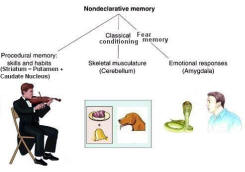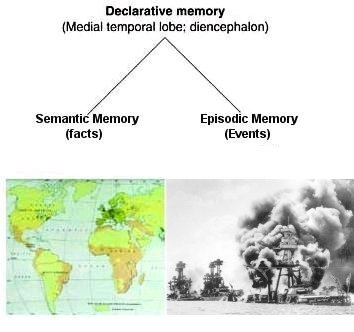The working memory
continued from the Brain Page of Memory
Contents
Neurons and Nervesneurotransmitter
The Brain & Spinal Cord
Cranial Nerves
Peripheral Nervous System
Autonomic Nervous System
Senses: Eye diagrams, Hearing, Smell, Taste, Taste & Tongue Sensation, Balance
Memory , Memory types, Creation of Memory,
Higher Functions
Altered States
Memory
- The working memory itself is located in the prefrontal cortex. As experimental techniques became refined, it has become clear that there is no rigid dividing line between a memory and a thought. A model of working memory has been developed to combine perceptions, memories and concepts together, and consists of three parts:
- Phonological loop - Memory in this area (see Figure 25) enables us to remember sequences of approximately seven digits, letter, or words. The language areas of the brain are mainly in the left hemisphere, around and above the ear. The language loop start with hearing words in the auditory cortex and/or reading words in the visual cortex. Perception of language results from the convergence of auditory and visual information in Wernicke's area. Expression of language is controlled by Broca's area; while the angular gyrus is concerned with meaning.
- Visual-spatial scratch pad - It is like a sort of inner eye, which receives and codes data into visual or spatial images. For example, it comes into play when we need to remember where we were on a page when we start reading a book again. Functional imaging suggests that this complex structure represents the "what" and "where" in short-term memory (see Figure 25).
- Central executive - This most important yet least well understood component of the working memory model, is postulated to be responsible for the selection, initiation, and termination of processing routines (e.g., encoding, storing, retrieving). It is believed that this component coordinates information from a number of sources, directs the ability to focus and switch attention, organizes incoming material and the retrieval of old memories and combines information arriving via the other two temporary storage systems. It performs various tasks such as reasoning or doing mental arithmetic - rather like the RAM (Radom Access Memory) of a computer.

Figure 26 Nondeclarative Memory
[view large image]
essential for emotional conditioning. Nondeclarative memory can be classified to five main groups:
- Procedural memory - It is the repository of such skills as handwriting or driving. These skills are essential part of our memory store, but it is difficult to describe the "know-how" in words. In this sense the memory is said to be implicit or non-declarative (Figure 26); you just cannot explain how to ride a bicycle. The skills may be difficult to acquire, but once learnt they are never forgotten, even without occasional practice. Thus it seems that the know-ledge or information required for the execution of very complex motor routines or procedures is somehow laid down in a robust permanent memory store. The parts of the brain involved in the acquisition of complex motor skills are the cerebellum and putamen (see Figure 24). Deeply ingrained habits are stored in the caudate nucleus.
- Classical conditioning - Along with motor skills, conditioning is part of non-declarative memory. The desire for food at a particular time of day - regardless of whether hungry or not - is one example of such conditioning. A classical example is to associate the ring of a bell to food when feeding a dog. After repeating the training many times, the dog shows salivation at the ring of the bell even without food (see Figure 26).
- Fear memory - Recent study in delivering shocks to mice suggests that fear memory does not occur immediately after a painful event; rather, it takes time for the memory to become part of our consciousness. The initial event activates NMDA receptors - molecules on cells that receive messages and then produce specific physiological effect in the cell - which are normally quiet but triggered when the brain receives a shock. Over time, the receptors leave their imprint on brain cells. A phobia is an excessive or unreasonable fear of an object, place or situation. Examples include fears of specific things such as insect, snake, mouse, and flying. It seems that people can learn to suppress a fright reaction by repeatedly confronting, in a safe manner, the fear-triggering memory or stimulus. It is found that for specific phobias, up to 90% of people can be cured through such exposure therapy.
- Nonassociative memory - Nonassociative memory includes two forms of learning called habituation and sensitization. Habituation is defined as a decreased in response to a repeated stimulus such as a certain odor. On the other hand, sensitization is an increased responsiveness such as more sensitive in touching a cut in the skin. Nonassociative learning involves reflex pathways in the spinal cord and elsewhere.
- Remote memory - The memory of events that occurred in
the distant past is referred to as remote memory. The underlying anatomy of remote memory is poorly understood, in part because testing this type of memory must be
personalized to a patient�s autobiographical past. What is known is that, like semantic memory, remote memory eventually becomes independent of the hippocampus. One
memory model shows a linear representation of how experience is processed as memory: Stimulus

Sensory Registration

Attention
Short Term Memory
Consolidation - Retrieval Long Term Memory
Long Term Memory Remote Memory. At the stage of sensory registration, there is a matching/assigning of the pattern to a meaning. Short-term memory is temporary and is limited in space. If
short-term memory is not repeated, the information is lost fairly quickly. Long term memory is consolidated and stored throughout the nervous system. Remote memories represent the
foundation memories upon which more recent memories are built. Since early acquired information is the foundation for new memories and may be linked to many more new
memories, such memory is less subject to change and/or loss. Similar to the short-term memory, the remote memories are not usually affected by aging.
Remote Memory. At the stage of sensory registration, there is a matching/assigning of the pattern to a meaning. Short-term memory is temporary and is limited in space. If
short-term memory is not repeated, the information is lost fairly quickly. Long term memory is consolidated and stored throughout the nervous system. Remote memories represent the
foundation memories upon which more recent memories are built. Since early acquired information is the foundation for new memories and may be linked to many more new
memories, such memory is less subject to change and/or loss. Similar to the short-term memory, the remote memories are not usually affected by aging.

Figure 27 Long-term Memory
[view large image]
Semantic, and episodic memory are the subclasses of declarative memory:

- Episodic memory - It is about an event in one's life and everything about it, including emotional reactions. Remembering an episode, e.g., the attack on Pearl Harbour (Figure 28), is to create a memory for a unique event that only happened once and there is no opportunity for learning the event by rehearsal. Episodic memories are not very reliable, they are highly personal, selective, idiosyncratic and varying over time, but they may also be richly complex and movie-like in character. They constitute the stories we tell ourselves about our past, they are the things we would write about in our autobiography. Episodic memories can be recalled deliberately or are triggered by evocative sensory stimuli - particularly by the sense of
Figure 28 Declarative Memory
[view large image]
smell. Episodic memory involves the use of the hippocampus for forming memories and the cortex for storage (see diagram D, Figure 24).
- Semantic memory - Semantic memory is the knowledge of facts - numbers, addresses, language and concepts - which the brain files in categories and which seems to involve the left temporal lobe. Retrieval is then carried out by the frontal lobes (see diagram E, Figure 24). We assume all of the facts that constitute our knowledge of things must be stored in an organized fashion to be useful. Though this has not been demonstrated, it seems likely that the brain stores our semantic memories as modules that have some logical links to one another; they are grouped by category for instance. On retrieval, the brain knows where to find the memory according to the address of that particular category. Semantic memory is essential to the understanding of how things work and thus to an under-standing of the world we live in. It is a body of knowledge that helps us to regulate our behaviour according to and dependent on reliable factual memories. Navigational skills, for example, depend on our ability to deploy a complex store of semantic memory, including detailed spatial memories and representations of the world.